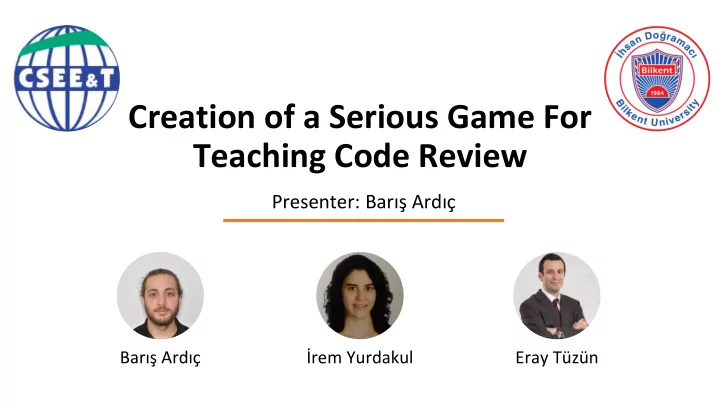

Creation of a Serious Game For Teaching Code Review Presenter: Barış Ardıç Barış Ardıç İrem Yurdakul Eray Tüzün
Outline I. Serious Games II. Code Review Process III. Workflow of the study IV. Learning Objectives V. Game Flow VI. Preliminary Experiment VII. Future Directions
Serious Games ● A game with a different main purpose than entertainment. ● A concept similar to gamification. ● Game elements are parts of the core functionality. ● Aim is to provide a platform that introduces code review while allowing students to practice.
Code Review Process • A manual inspection of source code by developers other than the author. • Frequently used practice in software development • Improves code quality if done right . • Often not addressed in software engineering curriculums.
Workflow of the Study
Learning Objectives • Main objectives are rows A and C. • B consists of game concepts. • Objectives are realised by game concepts.
Learning Objectives • Review Related Parameters: o Review size o Time spent on review • Process Related Parameters: o Review workflow o Actors and responsibilities
Learning Objectives • Finding smells improve code quality. • Defect classification [4] helps communication. • Code standards help provide evolvability. [4] M. Mantyla and C. Lassenius, “What types of defects are really discovered in code reviews? ”IEEE Trans. Software Eng., vo l. 35, no. 3,pp. 430 – 448, 2009.
Game Flow
Defect Selection The drop-down menu represents the defect classification taxonomy
Validation Strategy • Not a straightforward process. • Lack of validation is prevalent in the field. • We came up with a strategy inspired by social sciences. • Created an experiment for measuring differences after playing. • Test -> Play -> Test
Preliminary Experiment Setting • Pre-Survey : Overall and CR experience • Pre-Quiz : CR knowledge and programming • Gameplay: 5 levels • Post-Quiz: Same as Pre-Quiz • Post-Survey: Feedback and familiarity • Interviews: Rate quiz questions
Feedback From Participants • Detected some bugs and inconsistencies. • Improved the game content. • Added feature requests like: o Multiple reason support o Tutorial • Adjusted the experiment duration by omitting or adding quiz questions based on interviews.
Later Phases • Enhanced the game according to the preliminary feedback • Utilized in game as a lab assignment in Bilkent University • Followed the same experiment format. • The lab had 132 participants and was received positively. • Journal paper with the improved game and main experiment statistics and is in review.
Future Directions • We intend to add collaborative gameplay for knowledge transfer and team building. • An additional game mode from the authors perspective. • Code base can be extended for other SE processes. • More experiments are on their way as well.
Thank You for Listening Video Demo Github Page Full Paper
Recommend
More recommend